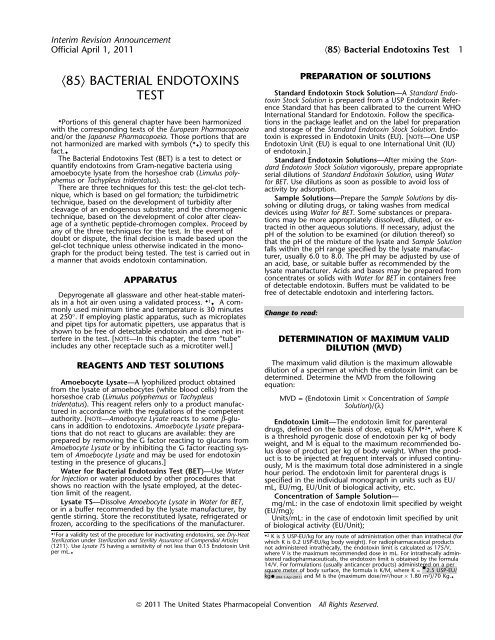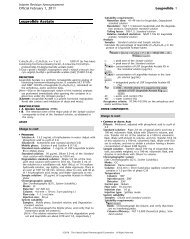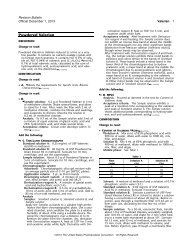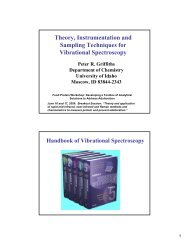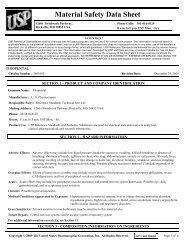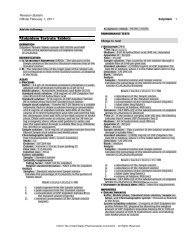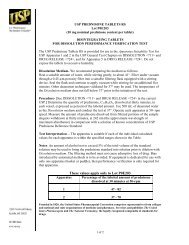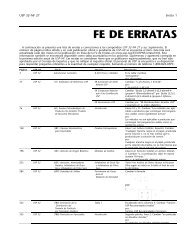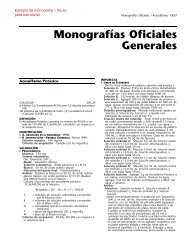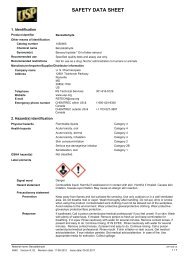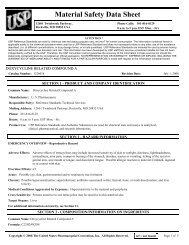〈85〉 bacterial endotoxins test - US Pharmacopeial Convention
〈85〉 bacterial endotoxins test - US Pharmacopeial Convention
〈85〉 bacterial endotoxins test - US Pharmacopeial Convention
Create successful ePaper yourself
Turn your PDF publications into a flip-book with our unique Google optimized e-Paper software.
Interim Revision Announcement<br />
Official April 1, 2011 〈85〉 Bacterial Endotoxins Test 1<br />
〈85〉 BACTERIAL ENDOTOXINS<br />
PREPARATION OF SOLUTIONS<br />
TEST Standard Endotoxin Stock Solution—A Standard Endotoxin<br />
Stock Solution is prepared from a <strong>US</strong>P Endotoxin Reference<br />
Standard that has been calibrated to the current WHO<br />
International Standard for Endotoxin. Follow the specifica-<br />
✦Portions of this general chapter have been harmonized tions in the package leaflet and on the label for preparation<br />
with the corresponding texts of the European Pharmacopoeia and storage of the Standard Endotoxin Stock Solution. Endoand/or<br />
the Japanese Pharmacopoeia. Those portions that are toxin is expressed in Endotoxin Units (EU). [NOTE—One <strong>US</strong>P<br />
not harmonized are marked with symbols ( ✦ ✦) to specify this Endotoxin Unit (EU) is equal to one International Unit (IU)<br />
fact.✦ of endotoxin.]<br />
The Bacterial Endotoxins Test (BET) is a <strong>test</strong> to detect or<br />
quantify <strong>endotoxins</strong> from Gram-negative bacteria using<br />
amoebocyte lysate from the horseshoe crab (Limulus polyphemus<br />
or Tachypleus tridentatus).<br />
There are three techniques for this <strong>test</strong>: the gel-clot technique,<br />
which is based on gel formation; the turbidimetric<br />
technique, based on the development of turbidity after<br />
cleavage of an endogenous substrate; and the chromogenic<br />
technique, based on the development of color after cleavage<br />
of a synthetic peptide-chromogen complex. Proceed by<br />
any of the three techniques for the <strong>test</strong>. In the event of<br />
doubt or dispute, the final decision is made based upon the<br />
gel-clot technique unless otherwise indicated in the monograph<br />
for the product being <strong>test</strong>ed. The <strong>test</strong> is carried out in<br />
a manner that avoids endotoxin contamination.<br />
Standard Endotoxin Solutions—After mixing the Stan-<br />
dard Endotoxin Stock Solution vigorously, prepare appropriate<br />
serial dilutions of Standard Endotoxin Solution, using Water<br />
for BET. Use dilutions as soon as possible to avoid loss of<br />
activity by adsorption.<br />
Sample Solutions—Prepare the Sample Solutions by dis-<br />
solving or diluting drugs, or taking washes from medical<br />
devices using Water for BET. Some substances or preparations<br />
may be more appropriately dissolved, diluted, or ex-<br />
tracted in other aqueous solutions. If necessary, adjust the<br />
pH of the solution to be examined (or dilution thereof) so<br />
that the pH of the mixture of the lysate and Sample Solution<br />
falls within the pH range specified by the lysate manufac-<br />
turer, usually 6.0 to 8.0. The pH may be adjusted by use of<br />
an acid, base, or suitable buffer as recommended by the<br />
lysate manufacturer. Acids and bases may be prepared from<br />
APPARAT<strong>US</strong><br />
concentrates or solids with Water for BET in containers free<br />
of detectable endotoxin. Buffers must be validated to be<br />
free of detectable endotoxin and interfering factors.<br />
Depyrogenate all glassware and other heat-stable materials<br />
in a hot air oven using a validated process. ✦1 ✦ A com-<br />
monly used minimum time and temperature is 30 minutes<br />
Change to read:<br />
at 250°. If employing plastic apparatus, such as microplates<br />
and pipet tips for automatic pipetters, use apparatus that is<br />
shown to be free of detectable endotoxin and does not interfere<br />
in the <strong>test</strong>. [NOTE—In this chapter, the term “tube” DETERMINATION OF MAXIMUM VALID<br />
includes any other receptacle such as a microtiter well.] DILUTION (MVD)<br />
REAGENTS AND TEST SOLUTIONS<br />
The maximum valid dilution is the maximum allowable<br />
dilution of a specimen at which the endotoxin limit can be<br />
Amoebocyte Lysate—A lyophilized product obtained<br />
from the lysate of amoebocytes (white blood cells) from the<br />
determined. Determine the MVD from the following<br />
equation:<br />
horseshoe crab (Limulus polyphemus or Tachypleus<br />
tridentatus). This reagent refers only to a product manufactured<br />
in accordance with the regulations of the competent<br />
MVD = (Endotoxin Limit × Concentration of Sample<br />
Solution)/(λ)<br />
authority. [NOTE—Amoebocyte Lysate reacts to some β-glucans<br />
in addition to <strong>endotoxins</strong>. Amoebocyte Lysate prepara-<br />
Endotoxin Limit—The endotoxin limit for parenteral<br />
drugs, defined on the basis of dose, equals K/M✦2✦, tions that do not react to glucans are available: they are<br />
prepared by removing the G factor reacting to glucans from<br />
Amoebocyte Lysate or by inhibiting the G factor reacting system<br />
of Amoebocyte Lysate and may be used for endotoxin<br />
<strong>test</strong>ing in the presence of glucans.]<br />
Water for Bacterial Endotoxins Test (BET)—Use Water<br />
for Injection or water produced by other procedures that<br />
shows no reaction with the lysate employed, at the detection<br />
limit of the reagent.<br />
Lysate TS—Dissolve Amoebocyte Lysate in Water for BET,<br />
or in a buffer recommended by the lysate manufacturer, by<br />
gentle stirring. Store the reconstituted lysate, refrigerated or<br />
frozen, according to the specifications of the manufacturer.<br />
where K<br />
is a threshold pyrogenic dose of endotoxin per kg of body<br />
weight, and M is equal to the maximum recommended bolus<br />
dose of product per kg of body weight. When the prod-<br />
uct is to be injected at frequent intervals or infused continu-<br />
ously, M is the maximum total dose administered in a single<br />
hour period. The endotoxin limit for parenteral drugs is<br />
specified in the individual monograph in units such as EU/<br />
mL, EU/mg, EU/Unit of biological activity, etc.<br />
Concentration of Sample Solution—<br />
mg/mL: in the case of endotoxin limit specified by weight<br />
(EU/mg);<br />
Units/mL: in the case of endotoxin limit specified by unit<br />
of biological activity (EU/Unit);<br />
✦1For a validity <strong>test</strong> of the procedure for inactivating <strong>endotoxins</strong>, see Dry-Heat ✦2 K is 5 <strong>US</strong>P-EU/kg for any route of administration other than intrathecal (for<br />
Sterilization under Sterilization and Sterility Assurance of Compendial Articles which K is 0.2 <strong>US</strong>P-EU/kg body weight). For radiopharmaceutical products<br />
〈1211〉. Use Lysate TS having a sensitivity of not less than 0.15 Endotoxin Unit not administered intrathecally, the endotoxin limit is calculated as 175/V,<br />
per mL.✦ where V is the maximum recommended dose in mL. For intrathecally administered<br />
radiopharmaceuticals, the endotoxin limit is obtained by the formula<br />
14/V. For formulations (usually anticancer products) administered on a per<br />
square meter of body surface, the formula is K/M, where K = •2.5 <strong>US</strong>P-EU/<br />
kg• (IRA 1-Apr-2011) and M is the (maximum dose/m2/hour × 1.80 m 2)/70 Kg.✦<br />
© 2011 The United States <strong>Pharmacopeial</strong> <strong>Convention</strong> All Rights Reserved.
Interim Revision Announcement<br />
2 〈85〉 Bacterial Endotoxins Test Official April 1, 2011<br />
Table 1. Preparation of Solutions for the Inhibition/Enhancement Test for Gel-Clot Techniques<br />
Endotoxin Concentration/<br />
Solution to Which Endotoxin Dilution Endotoxin Number of<br />
Solution Is Added Diluent Factor Concentration Replicates<br />
A a None/Sample Solution — — — 4<br />
B b 2λ/Sample Solution Sample Solution 1 2λ 4<br />
2 1λ 4<br />
4 0.5λ 4<br />
8 0.25λ 4<br />
C c 2λ/Water for BET Water for BET 1 2λ 2<br />
2 1λ 2<br />
4 0.5λ 2<br />
8 0.25λ 2<br />
D d None/Water for BET — — — 2<br />
a Solution A: A Sample Solution of the preparation under <strong>test</strong> that is free of detectable <strong>endotoxins</strong>.<br />
b Solution B: Test for interference.<br />
c Solution C: Control for labeled lysate sensitivity.<br />
d Solution D: Negative control of Water for BET.<br />
mL/mL: when the endotoxin limit is specified by volume positive. A result is negative if an intact gel is not formed.<br />
(EU/mL). The <strong>test</strong> is considered valid when the lowest concentration<br />
λ: the labeled sensitivity in the Gel-Clot Technique (EU/mL) of the standard solutions shows a negative result in all replior<br />
the lowest concentration used in the standard regression cate <strong>test</strong>s.<br />
curve for the Turbidimetric Technique or Chromogenic The endpoint is the smallest concentration in the series of<br />
Technique. decreasing concentrations of standard endotoxin that clots<br />
the lysate. Determine the geometric mean endpoint by calculating<br />
the mean of the logarithms of the endpoint con-<br />
Change to read: centrations of the four replicate series and then taking the<br />
antilogarithm of the mean value, as indicated in the following<br />
formula:<br />
GEL-CLOT TECHNIQUE Geometric Mean Endpoint Concentration = antilog (Σe/f)<br />
The gel-clot technique is for detecting or quantifying en-<br />
dotoxins based on clotting of the lysate reagent in the pres-<br />
ence of endotoxin. The minimum concentration of endo-<br />
toxin required to cause the lysate to clot under standard<br />
conditions is the labeled sensitivity of the lysate reagent. To<br />
ensure both the precision and validity of the <strong>test</strong>, perform<br />
the <strong>test</strong>s for confirming the labeled lysate sensitivity and for<br />
interfering factors as described under Preparatory Testing,<br />
immediately below.<br />
Preparatory Testing<br />
Test for Confirmation of Labeled Lysate Sensitivity—<br />
Confirm in four replicates the labeled sensitivity, λ, ex-<br />
pressed in EU/mL of the lysate prior to use in the <strong>test</strong>. The<br />
<strong>test</strong> for confirmation of lysate sensitivity is to be carried out<br />
when a new batch of lysate is used or when there is any<br />
change in the <strong>test</strong> conditions that may affect the outcome<br />
of the <strong>test</strong>. Prepare standard solutions having at least four<br />
concentrations equivalent to 2λ, λ, 0.5λ, and 0.25λ by diluting<br />
the <strong>US</strong>P Endotoxin RS with Water for BET.<br />
Mix a volume of the Lysate TS with an equal volume<br />
(such as 0.1-mL aliquots) of one of the Standard Endotoxin<br />
Solutions in each <strong>test</strong> tube. When single <strong>test</strong> vials or ampuls<br />
containing lyophilized lysate are used, add solutions directly<br />
to the vial or ampul. Incubate the reaction mixture for a<br />
constant period according to the directions of the lysate<br />
manufacturer (usually at 37 ± 1° for 60 ± 2 minutes), avoid-<br />
ing vibration. To <strong>test</strong> the integrity of the gel, take each tube<br />
in turn directly from the incubator and invert it through<br />
about 180° in one smooth motion. If a firm gel has formed<br />
that remains in place upon inversion, record the result as<br />
where Σe is the sum of the log endpoint concentrations of<br />
the dilution series used, and f is the number of replicate <strong>test</strong><br />
tubes. The geometric mean endpoint concentration is the<br />
measured sensitivity of the lysate (in EU/mL). If this is not<br />
less than 0.5λ and not more than 2λ, the labeled sensitivity<br />
is confirmed and is used in <strong>test</strong>s performed with this lysate.<br />
Test for Interfering Factors—Usually prepare solutions<br />
(A–D) as shown in Table 1, and perform the inhibition/en-<br />
hancement <strong>test</strong> on the Sample Solutions at a dilution less<br />
than the MVD, not containing any detectable <strong>endotoxins</strong>,<br />
operating as described for Test for Confirmation of Labeled<br />
Lysate Sensitivity. The geometric mean endpoint concentrations<br />
of Solutions B and C are determined using the formula<br />
described in the Test for Confirmation of Labeled Lysate Sensitivity.<br />
•The <strong>test</strong> for interfering factors must be repeated<br />
when any condition changes that is likely to influence the<br />
result of the <strong>test</strong>.• (IRA 1-Apr-2011)<br />
The <strong>test</strong> is considered valid when all replicates of Solu-<br />
tions A and D show no reaction and the result of Solution C<br />
confirms the labeled sensitivity.<br />
If the sensitivity of the lysate determined in the presence<br />
of Solution B is not less than 0.5λ and not greater than 2λ,<br />
the Sample Solution does not contain factors that interfere<br />
under the experimental conditions used. Otherwise, the<br />
Sample Solution to be examined interferes with the <strong>test</strong>.<br />
If the sample under <strong>test</strong> does not comply with the <strong>test</strong> at<br />
a dilution less than the MVD, repeat the <strong>test</strong> using a greater<br />
dilution, not exceeding the MVD. The use of a more sensitive<br />
lysate permits a greater dilution of the sample to be<br />
examined, and this may contribute to the elimination of<br />
interference.<br />
Interference may be overcome by suitable treatment, such<br />
as filtration, neutralization, dialysis, or heating. To establish<br />
© 2011 The United States <strong>Pharmacopeial</strong> <strong>Convention</strong> All Rights Reserved.
Interim Revision Announcement<br />
Official April 1, 2011 〈85〉 Bacterial Endotoxins Test 3<br />
Table 3. Preparation of Solutions for the Gel-Clot Assay<br />
Endotoxin Concentration/<br />
Solution to Which Endotoxin Dilution Endotoxin Number of<br />
Solution Is Added Diluent Factor Concentration Replicates<br />
A a None/Sample Solution Water for BET 1 — 2<br />
2 — 2<br />
4 — 2<br />
8 — 2<br />
B b 2λ/Sample Solution — 1 2λ 2<br />
C c 2λ/Water for BET Water for BET 1 2λ 2<br />
2 1λ 2<br />
4 0.5λ 2<br />
8 0.25λ 2<br />
D d None/Water for BET — — — 2<br />
a Solution A: Sample Solution under <strong>test</strong> at the dilution, not to exceed the MVD, with which the Test for Interfering Factors was completed. Subsequent dilution<br />
of the Sample Solution must not exceed the MVD. Use Water for BET to make a dilution series of four tubes containing the Sample Solution under <strong>test</strong> at<br />
concentrations of 1, 1 /2, 1 /4, and 1 /8 relative to the concentration used in the Test for Interfering Factors. Other dilutions up to the MVD may be used as<br />
appropriate.<br />
b Solution B: Solution A containing standard endotoxin at a concentration of 2λ (positive product control).<br />
c Solution C: Two replicates of four tubes of Water for BET containing the standard endotoxin at a concentration of 2λ, λ, 0.5λ, and 0.25λ, respectively.<br />
d Solution D: Water for BET (negative control).<br />
that the chosen treatment effectively eliminates interference plies with the <strong>test</strong> if a negative result is found for both repliwithout<br />
loss of <strong>endotoxins</strong>, perform the assay described cates of Solution A. The preparation does not comply with<br />
above using the preparation to be examined to which <strong>US</strong>P the <strong>test</strong> if a positive result is found for one or both replicates<br />
Endotoxin RS has been added and which has then been of Solution A. However, if the preparation does not comply<br />
submitted to the chosen treatment. with the <strong>test</strong> at a dilution less than the MVD, the <strong>test</strong> may<br />
be repeated using a greater dilution, not exceeding the<br />
MVD.<br />
Limit Test<br />
Quantitative Test<br />
Procedure—Prepare Solutions A, B, C, and D as shown in<br />
Table 2, and perform the <strong>test</strong> on these solutions following<br />
the procedure for Test for Confirmation of Labeled Lysate Sen- Procedure—The <strong>test</strong> quantifies <strong>bacterial</strong> <strong>endotoxins</strong> in<br />
sitivity under Preparatory Testing, above. Sample Solutions by titration to an endpoint. Prepare Solutions<br />
A, B, C, and D as shown in Table 3, and <strong>test</strong> these<br />
solutions by following the procedure in the Test for Confir-<br />
Table 2. Preparation of Solutions for the Gel-Clot Limit Test mation of Labeled Lysate Sensitivity under Preparatory Testing.<br />
Solution<br />
Endotoxin Concentration/<br />
Solution to Which Number of<br />
Calculation and Interpretation—The <strong>test</strong> is considered<br />
valid when the following three conditions are met: (1) Both<br />
replicates of negative control Solution D are negative; (2)<br />
* A<br />
B<br />
C<br />
Endotoxin Is Added<br />
None/Diluted Sample Solution<br />
2λ/Diluted Sample Solution<br />
2λ/Water for BET<br />
Replicates<br />
2<br />
2<br />
2<br />
Both replicates of positive product control Solution B are<br />
positive; and (3) The geometric mean endpoint concentration<br />
of Solution C is in the range of 0.5λ to 2λ.<br />
To determine the endotoxin concentration of Solution A,<br />
D None/Water for BET 2 calculate the endpoint concentration for each replicate by<br />
* Prepare Solution A and the positive product control Solution B using a multiplying each endpoint dilution factor by λ. The endodilution<br />
not greater than the MVD and treatments as for the Test for<br />
Interfering Factors under Preparatory Testing. The positive control Solutions<br />
B and C contain the Standard Endotoxin Solution at a concentration corresponding<br />
to twice the labeled lysate sensitivity. The negative control Solution<br />
D consists of Water for BET.<br />
toxin concentration in the Sample Solution is the endpoint<br />
concentration of the replicates. If the <strong>test</strong> is conducted with<br />
a diluted Sample Solution, calculate the concentration of en-<br />
dotoxin in the original Sample Solution by multiplying by the<br />
dilution factor. If none of the dilutions of the Sample Solu-<br />
Interpretation—The <strong>test</strong> is considered valid when both<br />
replicates of Solution B and C are positive and those of Solu-<br />
tion D are negative. When a negative result is found for<br />
both replicates of Solution A, the preparation under <strong>test</strong><br />
complies with the <strong>test</strong>. When a positive result is found for<br />
both replicates of Solution A, the preparation under <strong>test</strong><br />
does not comply with the <strong>test</strong>.<br />
When a positive result is found for one replicate of Solu-<br />
tion A and a negative result is found for the other, repeat<br />
the <strong>test</strong>. In the repeat <strong>test</strong>, the preparation under <strong>test</strong> comtion<br />
is positive in a valid assay, report the endotoxin concentration<br />
as less than λ (if the diluted sample was <strong>test</strong>ed, report<br />
as less than λ times the lowest dilution factor of the<br />
sample.) If all dilutions are positive, the endotoxin concen-<br />
tration is reported as equal to or greater than the grea<strong>test</strong><br />
dilution factor multiplied by λ (e.g., initial dilution factor<br />
times 8 times λ in Table 3).<br />
The preparation under <strong>test</strong> meets the requirements of the<br />
<strong>test</strong> if the concentration of endotoxin in both replicates is<br />
less than that specified in the individual monograph.<br />
© 2011 The United States <strong>Pharmacopeial</strong> <strong>Convention</strong> All Rights Reserved.
Interim Revision Announcement<br />
4 〈85〉 Bacterial Endotoxins Test Official April 1, 2011<br />
Table 4. Preparation of Solutions for the Inhibition/Enhancement Test for Photometric Techniques<br />
Solution to Which<br />
Solution Endotoxin Concentration Endotoxin Is Added Number of Replicates<br />
A a None Sample Solution Not less than 2<br />
B b Middle concentration of the standard curve Sample Solution Not less than 2<br />
C c At least 3 concentrations (lowest concentration is Water for BET Each not less than 2<br />
designated λ)<br />
D d None Water for BET Not less than 2<br />
a Solution A: The Sample Solution may be diluted not to exceed MVD.<br />
b Solution B: The preparation under <strong>test</strong> at the same dilution as Solution A, containing added endotoxin at a concentration equal to or near the middle of the<br />
standard curve.<br />
c Solution C: The standard endotoxin at the concentrations used in the validation of the method described for Assurance of Criteria for the Standard Curve<br />
under Preparatory Testing (positive controls).<br />
d Solution D: Water for BET (negative control).<br />
PHOTOMETRIC QUANTITATIVE TECHNIQUES<br />
Turbidimetric Technique<br />
concentrations within the range indicated by the lysate<br />
manufacturer to generate the standard curve. Perform the<br />
assay using at least three replicates of each standard endotoxin<br />
concentration according to the manufacturer’s instructions<br />
for the lysate (volume ratios, incubation time, temperature,<br />
pH, etc.). If the desired range is greater than two logs<br />
This technique is a photometric assay measuring increases in the kinetic methods, additional standards should be inin<br />
reactant turbidity. On the basis of the particular assay cluded to bracket each log increase in the range of the stanprinciple<br />
employed, this technique may be classified as ei- dard curve. The absolute value of the correlation coeffither<br />
an endpoint-turbidimetric assay or a kinetic-turbidimet- cient, r, must be greater than or equal to 0.980, for the<br />
ric assay. The endpoint-turbidimetric assay is based on the range of endotoxin concentrations set up.<br />
quantitative relationship between the concentration of <strong>endotoxins</strong><br />
and the turbidity (absorbance or transmission) of<br />
the reaction mixture at the end of an incubation period.<br />
The kinetic-turbidimetric assay is a method to measure either<br />
the time (onset time) needed to reach a predetermined<br />
absorbance or transmission of the reaction mixture, or the<br />
rate of turbidity development. The <strong>test</strong> is carried out at the<br />
incubation temperature recommended by the lysate manufacturer<br />
(which is usually 37 ± 1°).<br />
Test for Interfering Factors—Select an endotoxin con-<br />
centration at or near the middle of the endotoxin standard<br />
curve. Prepare Solutions A, B, C, and D as shown in Table 4.<br />
Perform the <strong>test</strong> on Solutions A, B, C, and D at least in dupli-<br />
cate according to the instructions for the lysate employed,<br />
for example, concerning volume of Sample Solution and Ly-<br />
sate TS, volume ratio of Sample Solution to Lysate TS, incu-<br />
bation time, etc.<br />
The <strong>test</strong> is considered valid when the following conditions<br />
are met.<br />
Chromogenic Technique<br />
1. The absolute value of the correlation coefficient of the<br />
standard curve generated using Solution C is greater than or<br />
This technique is an assay to measure the chromophore<br />
released from a suitable chromogenic peptide by the reaction<br />
of <strong>endotoxins</strong> with lysate. On the basis of the particular<br />
assay principle employed, this technique may be classified as<br />
either an endpoint-chromogenic assay or a kinetic-chromogenic<br />
assay. The endpoint-chromogenic assay is based on<br />
the quantitative relationship between the concentration of<br />
<strong>endotoxins</strong> and the release of chromophore at the end of<br />
an incubation period. The kinetic-chromogenic assay is a<br />
method to measure either the time (onset time) needed to<br />
reach a predetermined absorbance of the reaction mixture,<br />
or the rate of color development. The <strong>test</strong> is carried out at<br />
the incubation temperature recommended by the lysate<br />
manufacturer (which is usually 37 ± 1°).<br />
equal to 0.980.<br />
2. The result with Solution D does not exceed the limit of<br />
the blank value required in the description of the lysate rea-<br />
gent employed, or it is less than the endotoxin detection<br />
limit of the lysate reagent employed.<br />
Calculate the mean recovery of the added endotoxin by<br />
subtracting the mean endotoxin concentration in the solu-<br />
tion, if any (Solution A, Table 4), from that containing the<br />
added endotoxin (Solution B, Table 4). In order to be consid-<br />
ered free of factors that interfere with the assay under the<br />
conditions of the <strong>test</strong>, the measured concentration of the<br />
endotoxin added to the Sample Solution must be within<br />
50% to 200% of the known added endotoxin concentration<br />
after subtraction of any endotoxin detected in the solution<br />
without added endotoxin.<br />
When the endotoxin recovery is out of the specified<br />
Preparatory Testing<br />
range, the Sample Solution under <strong>test</strong> is considered to contain<br />
interfering factors. Then, repeat the <strong>test</strong> using a greater<br />
To assure the precision or validity of the turbidimetric and<br />
chromogenic techniques, preparatory <strong>test</strong>s are conducted to<br />
verify that the criteria for the standard curve are valid and<br />
that the sample solution does not interfere with the <strong>test</strong>.<br />
Validation for the <strong>test</strong> method is required when conditions<br />
that are likely to influence the <strong>test</strong> result change.<br />
Assurance of Criteria for the Standard Curve—The <strong>test</strong><br />
must be carried out for each lot of lysate reagent. Using the<br />
Standard Endotoxin Solution, prepare at least three endotoxin<br />
dilution, not exceeding the MVD. Furthermore, interference<br />
of the Sample Solution or diluted Sample Solution not to ex-<br />
ceed the MVD may be eliminated by suitable validated<br />
treatment, such as filtration, neutralization, dialysis, or heat<br />
treatment.To establish that the treatment chosen effectively<br />
eliminates interference without loss of <strong>endotoxins</strong>, perform<br />
the assay described above using the preparation to be examined<br />
to which Standard Endotoxin has been added and<br />
which has then been submitted to the chosen treatment.<br />
© 2011 The United States <strong>Pharmacopeial</strong> <strong>Convention</strong> All Rights Reserved.
Interim Revision Announcement<br />
Official April 1, 2011 〈85〉 Bacterial Endotoxins Test 5<br />
Test Procedure<br />
Follow the procedure described for Test for Interfering Factors<br />
under Preparatory Testing, immediately above.<br />
Calculation<br />
Calculate the endotoxin concentration of each of the replicates<br />
of Solution A using the standard curve generated by<br />
the positive control Solution C. The <strong>test</strong> is considered valid<br />
when the following three requirements are met.<br />
1. The results of the control Solution C comply with the<br />
requirements for validation defined for Assurance of Criteria<br />
for the Standard Curve under Preparatory Testing.<br />
2. The endotoxin recovery, calculated from the concentration<br />
found in Solution B after subtracting the concentration<br />
of endotoxin found in Solution A, is within the range of 50%<br />
to 200%.<br />
3. The result of the negative control Solution D does not<br />
exceed the limit of the blank value required in the descrip-<br />
tion of the lysate employed, or it is less than the endotoxin<br />
detection limit of the lysate reagent employed.<br />
Interpretation<br />
In photometric assays, the preparation under <strong>test</strong> com-<br />
plies with the <strong>test</strong> if the mean endotoxin concentration of<br />
the replicates of Solution A, after correction for dilution and<br />
concentration, is less than the endotoxin limit for the<br />
product.<br />
© 2011 The United States <strong>Pharmacopeial</strong> <strong>Convention</strong> All Rights Reserved.


